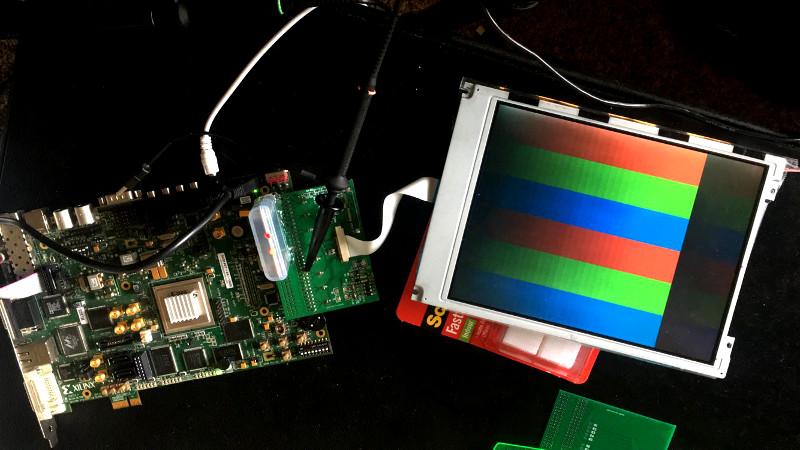If you’re reading this article on a desktop or laptop computer, you’re probably staring at millions of pixels on a TFT LCD display. TFT became a dominant technology due to its picture quality and fast response times, but it’s not the only way to build an LCD. There are cheaper technologies, such as STN and its color variant, CSTN. They’re rarely used nowadays, but [Wenting Zhang] had one lying around and wanted to take a crack at driving it.

The screen in question came courtesy of a 20th century laptop. It’s a Hitachi SX21V001-Z4, with a resolution of 640×480 pixels. Driver boards for CSTN screens were once readily available, however now such things are difficult to come by.
[Wenting] instead grabbed an FPGA and got to work. Driving displays can be taxing for small microcontrollers, so an FPGA is always a great choice when working on such projects. They’re easily capable of generating whatever weird and wacky signals are required, and can generate many such signals in parallel without breaking a sweat.
[Wenting] successfully got the screen up and running, and hooked up to a VGA input. Image quality is surprisingly passable for still images, though things absolutely go to pieces when motion is introduced. [Wenting]’s demo shows off the screen playing Breath of the Wild, and it’s a great showcase of how far technology has come since the mid-90s.
Driving strange LCDs is a hacker rite of passage, and we see plenty of efforts around these parts. Video after the break.
















Used to be called “passive matrix” when the good displays were active matrix. These days the laptops all have an active matrix display so to have a low price point you can get a 1366×768 resolution display on almost any laptop, even the high end business class ones.
Could the LCD industry just suddenly decide to not make that low resolution anymore?
Other industries at various times in history have done that with different technologies. One example is with gears. Some time after WW2 every machine tool company and gear supplier just quit using 14 Diametrical Pitch. 13DP, 15DP yes. 14DP no, except one company in the UK that has 14DP stock gears, but only in 20 degree Pressure Angle, so one still cannot buy a stock gear to repair some old machines because the antiques with 14DP gears nearly all used 14.5PA.
“Could the LCD industry just suddenly decide to not make that low resolution anymore?”
Fab yields likely increase at some exponential, or at least non-linear rate, as the resolution decreases. I imagine that is why such relatively low-resolution displays have competitive market staying power.
That ticks me off a bit, how you really have to hunt to get better than 768 height. Got some real nice screens on a couple of mid noughties machines that are getting too old for even Lubuntu, 1600×1200 on a slug of a P4, 1440×900 on a gateway with early AMD64… then core2 era with at least 800 vertical and then everything sandy bridge or better is stuck with 768… Yes I know there were better models out there, but just saying how the common ones seem to be going backwards in display res. Probably R&D funds getting spent on making them lighter, thinner, more durable and lower power I guess.
I’d look more into interfacing the older higher res panels to newer CPU, but as far as my collection goes it’s tryna get 15″ panels into 14″ frames or 4:3 into 16:10 bezels and similar nonsense.
Driving a LCD with a FPGA is a bit of a high bar for a right-of-passage.
Yeah, right? Ten years ago, it was super-duper hard. Nowadays, I’d go with only pretty hard. It’s not blinking LEDs, though.
I suppose there’s…. Levels.
Somebody that can do this (from scratch), I’d consider ‘pretty good’.
But when some kid is blinking a light from an Arduino, after his first visit to a hackerspace, one can tell whether the kid ‘has the gene’, or not.
I’ve been told once that, with the advent of XT/AT-PC’s, in certain circles you were considered pretty ‘1337’, if you soldered together your own graphics card. Personally I’ve been looking into driving stuff directly from an ISA / PCI slot, but never really got around to it.. ^_^
Perhaps you could have some smarts in the FPGA to avoid or reduce any panel display issues.